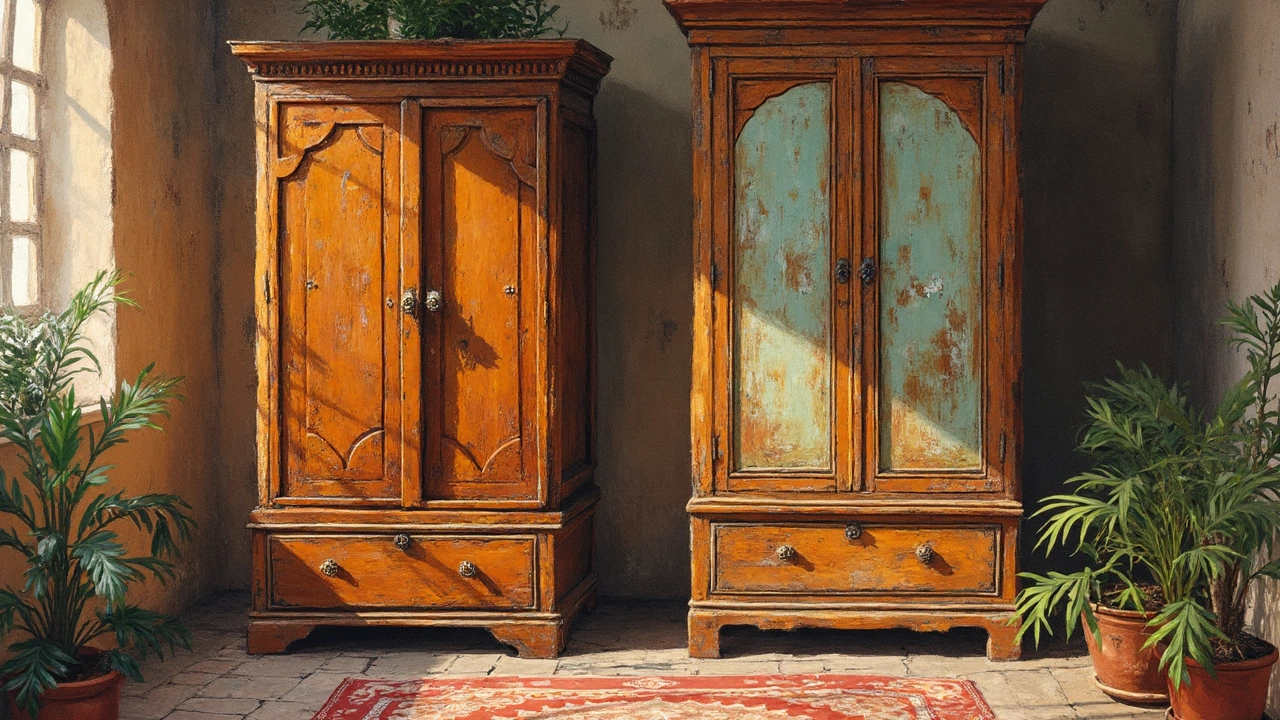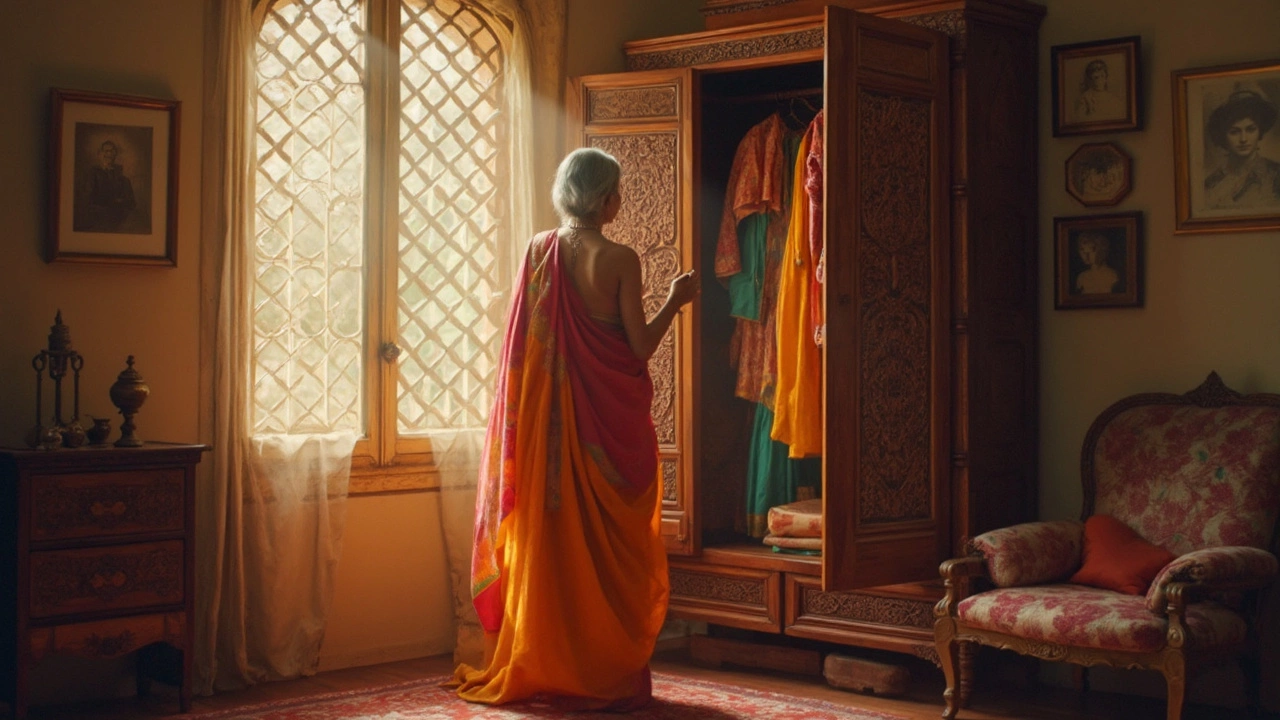Got an old closet sitting in your room and not sure what to call it? You’re not alone. People toss around words like 'wardrobe,' 'armoire,' or even 'chifforobe,' but they aren’t just random names. Each has its own story and style, and knowing which is which can actually help if you’re hunting for furniture, planning a room makeover, or just trying to impress your friends with some fun facts.
Knowing the right term can save you a lot of confusion if you ever shop for vintage furniture. A seller calling a piece an 'armoire' might not be offering the same thing as a 'wardrobe.' And if you come across the term 'chifforobe'—trust me, it’s not a spelling mistake. The names matter when you’re looking at age, function, and origin.
- What's in a Name? Common Terms for Old Closets
- The Difference Between a Wardrobe, Armoire, and Chifforobe
- A Quick History of Freestanding Wardrobes
- How to Recognize a Genuine Antique Closet
- Care and Restoration Tips for Vintage Closets
- Why Old Closets Are Still Cool Today
What's in a Name? Common Terms for Old Closets
If you’ve checked out estate sales or old houses, you’ve probably heard a bunch of different names for those big, standalone clothing cabinets. The main ones are wardrobe, armoire, and chifforobe. They each mean something a little different, but they all refer to what most of us think of as an old closet.
A wardrobe is just a tall, freestanding cabinet with doors. Inside, you’ll usually find a hanging rail and maybe some shelves or drawers. Most vintage British homes didn’t have built-in closets until the mid-20th century, so wardrobes were must-haves.
An armoire is a bit fancier, usually coming from France. Think big, decorative, and sometimes carved wood. Armoires first popped up in the 17th century and were a sign you’d made it. You’ll usually see them in old European homes or high-end antique shops.
Then there’s the chifforobe. This is a sort of hybrid between a wardrobe and a chest of drawers. It’s one tall section for hanging clothes, and another with stacked drawers. The word showed up mostly in the U.S. South in the early 1900s, so you’ll run into it in American vintage furniture shops.
- Wardrobe: Plain or fancy, used mainly in Britain and Europe.
- Armoire: French, decorative, sometimes massive.
- Chifforobe: Has both hanging space and drawers, more common in the U.S.
People sometimes get creative with names, so you might also hear “gentleman’s wardrobe” (that’s one with more drawers), “linen press” (which is mostly for sheets and towels), or just “closet,” even if it’s not built-in. Sellers love to use the fanciest word possible, but knowing the difference can help you spot a true vintage wardrobe or antique armoire.
| Name | Main Feature | Common Region |
|---|---|---|
| Wardrobe | Hanging rail, shelves | UK, Europe |
| Armoire | Large, decorative, carved wood | France, Europe |
| Chifforobe | Hanging space + drawers | USA |
When you see these names in ads or at auctions, it’s not just fancy marketing—each has a backstory. If you’re hunting for a vintage wardrobe or unique storage, ask sellers which type they’re really offering so you’re not surprised later.
The Difference Between a Wardrobe, Armoire, and Chifforobe
When it comes to old closets, most folks use wardrobe, armoire, and chifforobe like they all mean the same thing. They don’t. It’s not just about regional slang—these pieces are actually built differently and have their own background.
The classic wardrobe is pretty straightforward. At its core, it's a tall, freestanding cabinet with doors that open up to a big space for hanging clothes. Usually, there are no built-in drawers—just a rail for hangers and maybe a shelf up top. Wardrobes showed up big-time in Victorian England, mostly because houses didn’t have built-in closets yet.
An armoire is a little fancier. The word comes from French and originally meant a storage place for armor (yeah, like knights). Over time, it turned into any huge, ornate cabinet with doors, sometimes jam-packed with carvings or mirrors. French-style armoires often have more detail than English wardrobes, and you’ll sometimes see drawers or shelves inside for extras.
The chifforobe is the newcomer. The name mashes up "chiffonier" (which means a tall dresser) and "wardrobe." So, a chifforobe has a space for hanging clothes and a set of drawers—think two-in-one furniture. These started showing up in the early 1900s, especially in American homes where space was tight.
“A wardrobe is for hanging your suits, an armoire is for hosting a party inside your furniture, and a chifforobe is what you get when you can’t pick one.” – Antiques Roadshow appraiser, 2021
If you ever shop secondhand or hit an antique store, here’s how you can spot the difference:
- Wardrobe: Tall, plain, mainly for hanging clothes. Few or no drawers inside.
- Armoire: Heavier, decorative, and often comes with shelves or even mirrors. French styles stand out for curved lines or painted panels.
- Chifforobe: One side has hanging space, the other has drawers. Handy if you’re short on room or budget.
To give you a quick comparison, check out this table:
| Type | Main Use | Features | Origin |
|---|---|---|---|
| Wardrobe | Hanging clothes | Large doors, hanging rail, simple design | England, 18th century |
| Armoire | General storage, clothing | Ornate woodwork, sometimes mirrors/shelves | France, 17th century |
| Chifforobe | Hanging + folded clothes | Drawers and hanging space combined | USA, early 20th century |
Next time you spot a "closet" at a flea market, now you’ll know exactly what you’re looking at—and probably know more than the seller.
A Quick History of Freestanding Wardrobes
Wardrobes haven’t always been household staples. If we rewind a few centuries, most folks didn’t even own extra clothes, let alone fancy places to stash them. In medieval Europe, people hung their garments on pegs or stored them in simple wooden chests. The idea of a wardrobe as a separate piece of furniture really started popping up in the 17th century, as people got more clothes to store and houses got bigger.
The earliest freestanding wardrobes were basically stacked cabinets with heavy doors, built bulky to keep out mice and the damp. The French took it to another level with the armoire—a tall, two-doored closet that started trending in palaces before making its way to regular homes. By the 18th century, this style was all over Europe, but usually reserved for the well-off since these big pieces were expensive to make and move.
Factory production during the Industrial Revolution made wardrobes more available. Designs got lighter, and drawers and mirrors became more common. In the U.S., you might bump into a chifforobe—a combo of drawers and closet in one, which got super popular in the early 1900s when houses started popping up with smaller closets, or none at all.
Here’s how wardrobe styles changed over time:
- 1600s: Simple, boxy cupboards with doors, wood planks nailed together.
- 1700s: Armoires become ornate, with carved panels and brass handles.
- 1800s: Freestanding wardrobes and chifforobes appear, sometimes with mirrors or hidden compartments.
- 1900s: Streamlined designs for easier moving, mass-produced to fit new home styles.
And here’s a quick comparison of popular old closets and when they came into the picture:
| Name | First Popularity | Main Feature |
|---|---|---|
| Wardrobe | 1600s | Tall, basic storage cabinet |
| Armoire | 1700s (France) | Decorative, often with curves and carving |
| Chifforobe | 1900s (USA) | Combo of drawers and hanging space |
If you spot an older piece with wide panels, chunky locks, or leftover candle scorches, you’re probably looking at something with a story. All these styles had one mission: to keep clothes safe, tidy, and—if you were fancy—on display.

How to Recognize a Genuine Antique Closet
So, you’ve spotted something that looks like an old closet at a flea market, and you’re thinking, “Is this the real deal?” There are some tried and tested ways to figure out if you’re looking at a true antique or just a fancy piece made to look old. Here’s what you should check:
- Joinery: Take a good look at how the closet is put together. True antiques usually have dovetail joints, especially on drawers or doors. If you spot perfect, machine-made joints or a ton of screws, it’s probably younger than your grandma’s microwave.
- Hardware: Check the handles, hinges, and locks. Old brass or iron fittings usually have a nice patina (that greenish or brownish aging look). If the hardware is shiny and new, it might be a replacement.
- Back Panels and Bottoms: Authentic vintage wardrobes and armoires were often made with thin, wide boards on the back or bottom. These boards might have tool marks or even old woodworm holes. Plywood or particle board panels? Nope, too modern.
- Wear and Tear: A genuine antique furniture piece isn’t going to look perfect. Expect dents, scratches, or smooth edges, especially around handles, locks, and corners. These come from years of honest use, not just a sanding block and some paint.
- Smell Test: Open the doors and take a sniff. Real antiques often have that old wood smell—sort of musty, but not bad. Newer pieces or fakes might just smell like fresh wood or glue.
- Provenance: Sometimes, you’ll find a tag, stamp, or even a handwritten date somewhere inside. If you see a label from a known furniture maker (like Hepplewhite or Chippendale), that’s a good sign. But watch out—these too can be faked, so use other clues in this list too.
If you’re still not sure, grab your phone and look up a few details or even check out a antique furniture price guide online. Here’s a quick snapshot to help you check how age shows up in various parts of an old closet:
| Feature | Real Antique | Modern/Fake |
|---|---|---|
| Back Panel | Single wide board, tool marks | Plywood or particle board |
| Drawers | Dovetail joints, uneven edges | Screws, perfect joints |
| Hardware | Patina, sometimes rust | Polished, machine-made |
| Finish | Faded, some scratches | Even, glossy, too perfect |
Armed with these tips, you’ll be way less likely to get fooled by a wannabe relic. True old closets usually have a mix of handcraft, age, and real life wear that’s hard to copy. If you ever have doubts, snap a photo and run it past an antiques dealer or join an online forum—people love to help ID vintage finds.
Care and Restoration Tips for Vintage Closets
If you’ve picked up a vintage wardrobe or struck gold with an antique armoire, don’t let it gather dust or fall apart. Proper care makes a huge difference if you want these old closets to last another few decades (or more). The first step is always assessing the overall condition—check for loose joints, water damage, or missing parts. Don’t ignore old hardware like hinges and handles; they’re easy to overlook but often crucial for function and value.
Cleaning comes next, but skip the all-purpose sprays and harsh chemicals—seriously, they can ruin old finishes. Instead, use a simple mix of warm water and mild soap for regular wipe-downs. For sticky, grime-packed spots, a bit of white vinegar can help, just don’t soak the wood. Always wipe dry right after to keep the wood from swelling up or warping.
- For scratches and dings, try using a wood touch-up marker or a matching wax crayon. Even a walnut rubbed into small scratches can help hide them.
- If the finish is looking faded, products like beeswax polish or lemon oil can bring back some shine without stripping the original look.
- Watch out for woodworms or termite holes. If you spot tiny pin-sized holes or sawdust, treat it immediately with a proper woodworm killer (this stuff can spread fast!).
- Never keep a vintage wardrobe right against a damp wall or in direct sunlight—the first causes rot, the second can bleach and crack the wood.
If you’re restoring a really old piece, sometimes it’s worth calling in a pro. Proper restoration—especially on rare antique furniture—can boost the value and keep the original character intact. But if you’re up for a bit of DIY, always test any product or cleaner on a hidden spot first. Older finishes react in unpredictable ways.
Here’s a quick comparison of popular cleaning and restoration products commonly used for old closets:
| Product | Use | Best For |
|---|---|---|
| Lemon Oil | Polishing & protecting | Semi-dull or faded wood |
| Beeswax Polish | Conditioning wood | Restoring shine and adding moisture |
| White Vinegar (diluted) | Cleaning | Sticky grime and spot cleaning |
| Woodworm Killer | Pest treatment | Any visible holes or sawdust evidence |
The key is patience—never rush an old closet’s restoration. Take your time, use the right products, and treat every part with care. That’s how you turn a dusty old closet into a statement piece with years left to give.
Why Old Closets Are Still Cool Today
The charm of old closets hasn’t vanished, even as people go crazy for built-in wardrobes and modern shelves. There’s actually a huge demand for these bulky beauties, especially pieces labeled as vintage wardrobes or antique armoires. You know why? First, they’re way sturdier than most new flat-pack furniture. Most old closets are made from solid wood—oak, walnut, mahogany—the kind that sticks around for generations. Not many modern pieces can say the same.
Design matters, too. Antique armoires and wardrobes come packed with details: carved doors, fancy hardware, and finishes you just can’t fake. Each piece usually has quirks and marks that show its history. If you’re into unique interiors, nothing beats having a statement closet that turns heads instead of blending in with everything else.
Another reason these pieces are still popular is storage flexibility. Don’t have a built-in closet? No problem. Roll in an armoire, and you get instant hanging space and shelves, sometimes even drawers. Old closets are lifesavers in older homes or rentals that just never got the closet memo.
If you care about sustainability, vintage wardrobes are eco-friendly by default. You’re not supporting fresh timber cuts or tossing more particleboard into the landfill. And, according to data from the Furniture History Society, classic armoires have a much longer average lifespan than most modern mass-market closets—up to 100 years or more if you keep them dry and clean.
| Type | Typical Wood | Average Lifespan |
|---|---|---|
| Armoire | Oak, Walnut | 100+ years |
| Vintage Wardrobe | Mahogany, Pine | 75-120 years |
| Flat-Pack Closet | Particleboard | 10-20 years |
If you ever feel like your space is too “cookie-cutter,” swapping in a classic wardrobe can really change the vibe. They mix well with all kinds of design styles, from farmhouse to modern. Plus, some folks say an old wardrobe instantly makes a bedroom feel more grown-up and put together—no assembly required.

